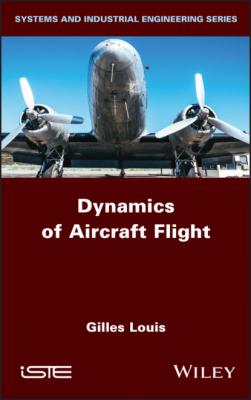Dynamics of Aircraft Flight. Gilles Louis
Чтение книги онлайн.
Читать онлайн книгу Dynamics of Aircraft Flight - Gilles Louis страница 1

Contents
1 Cover
4 Foreword
5 Introduction I.1. Definition of axes
6 1 Use of Aerodynamic Forces to Control the Trajectory of an Aircraft 1.1. Definitions 1.2. Pitch control 1.3. Yaw control 1.4. Roll control 1.5. The Mach: subsonic, transonic and supersonic speeds
7 2 Aerodynamic Forces and Moments and their Derivatives 2.1. Definitions 2.2. Aerodynamic forces 2.3. Aerodynamic moments 2.4. Major aerodynamic derivatives
8 3 Wind Tunnel 3.1. Description of wind tunnel tests 3.2. Stall 3.3. Calculation of the maximum stress applied to an aircraft wing in a wind tunnel
9 4 Trihedron 4.1. Writing convention 4.2. Definitions of trihedrons 4.3. Change of reference 4.4. Relation between trihedra 4.5. Relative positions of the various trihedra
10 5 Movement of a Solid 5.1. Rotation of a solid around a fixed point 5.2. Kinematics of a solid 5.3. Reference framework 5.4. Components of the instantaneous velocity vector of the aircraft reference (O, ie, je, ke)E with respect to the local geographic reference (O, ilgt, jlgt, klgt)LGT in the aircraft reference 5.5. Equations of accelerations and forces in the aircraft frame(O, ie, je, ke)E 5.6. Determination of load factors in the aircraft reference (O, ie, je, ke)E 5.7. Case where the speeds and accelerations are provided at a point other than G 5.8. Coordinates of the aerodynamic speed in aircraft axes 5.9. Equations of moments in the aircraft frame (O, ie, je, ke)E 5.10. Forces and moments applied to the aircraft
11 6 Aircraft Characteristics 6.1. Aerodynamics problems posed by aircraft 6.2. Load factor
12 7 Aircraft Simulation Model 7.1. Simulation model of the atmosphere 7.2. Propulsive coefficients 7.3. Mass coefficients 7.4. Aerodynamic coefficients 7.5. Equations of motion 7.6. Introduction of wind
13 8 Processing of Trajectography Information 8.1. Telemeasured parameters 8.2. Smoothing, first derivation and second derivation 8.3. Performance calculation 8.4. Aerodynamic route and slope 8.5. Determination of the angle Ψ 8.6. Load factors in the aerodynamic trihedron (O, Xa,Yaf, Zr) 8.7. Processing of data from the inertial unit (in the aircraft frame) 8.8. Determination of some aerodynamic parameters 8.9. Determination of load factors (nx1, ny1, nz1) in the aircraft trihedron 8.10. Determination of CY and Cz 8.11. Determination of the total incidence 8.12. Determination of the longitudinal attitude compared to the local horizontal plane 8.13. Determination of drag coefficients 8.14. Determination of the pushing force
14 9 Quaternion Methods 9.1. Goal 9.2. Reminder of the axis change formulas using